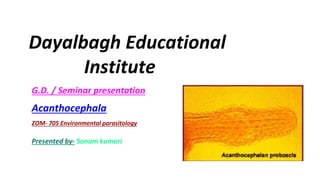Acanthocephala .pptx
•Descargar como PPTX, PDF•
0 recomendaciones•846 vistas
Acanthocephola life cycle and their morphology.
Denunciar
Compartir
Denunciar
Compartir

Recomendados
Más contenido relacionado
La actualidad más candente
La actualidad más candente (20)
ENTO 301 – MEDICAL & VETERINARY ENTOMOLOGY (Lectures 1-5) ENTO 301 – MEDICA...

ENTO 301 – MEDICAL & VETERINARY ENTOMOLOGY (Lectures 1-5) ENTO 301 – MEDICA...
Similar a Acanthocephala .pptx
Similar a Acanthocephala .pptx (20)
Class Trematoda. Tapeworms as parasites of human being

Class Trematoda. Tapeworms as parasites of human being
Último
Último (20)
Forensic Biology & Its biological significance.pdf

Forensic Biology & Its biological significance.pdf
Locating and isolating a gene, FISH, GISH, Chromosome walking and jumping, te...

Locating and isolating a gene, FISH, GISH, Chromosome walking and jumping, te...
pumpkin fruit fly, water melon fruit fly, cucumber fruit fly

pumpkin fruit fly, water melon fruit fly, cucumber fruit fly
9654467111 Call Girls In Raj Nagar Delhi Short 1500 Night 6000

9654467111 Call Girls In Raj Nagar Delhi Short 1500 Night 6000
Justdial Call Girls In Indirapuram, Ghaziabad, 8800357707 Escorts Service

Justdial Call Girls In Indirapuram, Ghaziabad, 8800357707 Escorts Service
Introduction,importance and scope of horticulture.pptx

Introduction,importance and scope of horticulture.pptx
Acanthocephala .pptx
- 1. Dayalbagh Educational Institute G.D. / Seminar presentation Acanthocephala Presented by- Sonam kumari
- 2. ○ Classification ● Kingdom - Animalia ● Subkingdom - Eumetazoa ● Phylum. - Acanthocephala ● Class -Eoacanthocephala ● Class -Palaeacanthocephala ● Class- Archiacanthocephala ● Class-Polyacanthocephala
- 3. History ● The earliest recognisable description n of Acanthocephala – a worm with a proboscis armed with hooks – was made by Italian author “Francesco Redi” (1684).[1] In 1771, “ ● koelreuthher” proposed the name Acanthocephala. ● “Philipp Ludwig Statius Muller” independently called them Echinorhynchus in 1776. “Karl Rudolphi” in 1809 formally named them Acanthocephala.
- 4. Acanthocephala ● Acanthocephala ( Spiny/ thorny-head). ● Name- Greek acantha- prickle and kephala-head. ● Acanthocephala ˈ is a phylum of parasitic worms known as acanthocephalans, thorny-headed worms, or spiny-headed worms, characterized by the presence of an eversible proboscis, armed with spines, which it uses to pierce and hold the gut wall of its host. ● Acanthocephalans have complex life cycles, involving at least two hosts, which may include invertebrates, fish, amphibians, birds, and mammals. About 1420 species have been described.
- 5. Acanthocephalans - Adult morphology ● Anterior - presoma( proboscis, neck). ● Main trunk - metasoma. ● Cuticular partition ● Proboscis and sheath ● Longitudinal and circular muscles. ● 2 Hydrastatic system - main Body cavity and proboscis sheath cavity. ● Eversion proboscis hydrostatic. ● Proboscis movement -lemnisci.
- 6. Acanthocephala - Body plan ► Body wall structure ► Absorb nutrients through body wall ► 5 Major layers- 1. Epicuticle layer 2. Cuticle Layer 3. Striped layer 4. Felt layer 5. Radial layer.
- 7. Respiration ● No respiratory system. ● Absorbs oxygen through tegument. ● No Digestive system in larva and adult. ● Exchange of gases, nutrients and wastes across body wall by diffusion. Digestion
- 8. Excretion ● If present, excretory system consists of 2 protonephridia. Nervous system ● Nervous system with central ganglion near suclike proboscis receptacle. ● But overall greatly reduced . Reproduction ● DIoecious, female larger than male .
- 9. Acanthocephala Causal Agents:- ● Acanthocephala (also known as spiny- or thorny-headed worms) are common parasites of wildlife and some domestic animal species, but they rarely infect humans. ● Species recovered from humans include Macracanthorynchus hirudinaceus, Macracanthorynchus ingens, Moniliformis moniliformis, Acanthocephalus rauschi, Pseudoacanthocephalus bufonis, Corynosoma strumosum, and Bolbosoma sp. M. hirudinaceus and M. moniliformis are the most common species implicated in human infections.(accidental Host ● Natural definitive hosts include rats (Moniliformis moniliformis), swine (Macracanthorynchus hirudinaceus), and raccoons (Macracanthorynchus ingens). ● The insect intermediate host varies by species but is usually scarabaeoid or hydrophilid beetles for M. hirudinaceus and likely M. ingens, and beetles or cockroaches for M. moniliformis
- 10. Life cycle ● Eggs are shed in the feces of the definitive hosts image . ● The eggs contain a fully developed acanthor when shed in feces. ● The eggs are ingested by an intermediate host image , which is always an insect. ● Within the hemocoelom of the insect, the acanthor image molts into a second larval stage, called an acanthella image . ● After 6–12 weeks, the worm reaches the infective stage called a cystacanth image . T ● The definitive host becomes infected upon ingestion of intermediate hosts containing infective cystacanths
- 11. ● the definitive host, liberated juveniles attach to the wall of the small intestine, where they mature image and mate in about 8–12 weeks. ● In humans image the worms seldom develop to full maturity or produce eggs.
- 12. Pathogenesis ● Clinical symptoms of acanthocephaliasis are often severe, due in part to the mechanical damage caused by the insertion of the armed proboscis into the lumen of the host’s intestine. ● No human infections. ● •Major problems fish farms. ● •Difficult to treat. ● Symptoms generally include abdominal pain and related digestive complaints. ● However, low-intensity or early infections may be asymptomatic ● Seasonal "outbreaks" of disease & mortality. In ducks n fishes.
- 13. Control Control 1. To control infections in coldwater fish farms, medicated feed with Bithionol (2.2-thio bis (4,6-dichlorophenol), is recommended, at a dose of 0.2 g/kg fish (Hoffman, 1983). 2. Feeds medicated with Di-N-butyl tin oxide are also potentially effective
- 14. Thank you